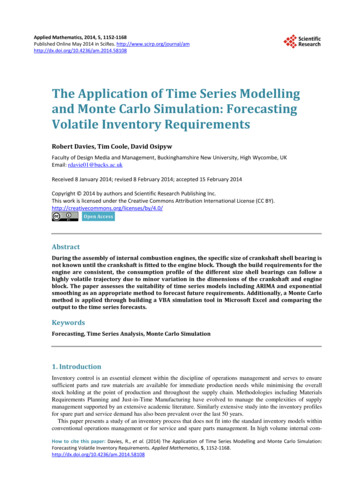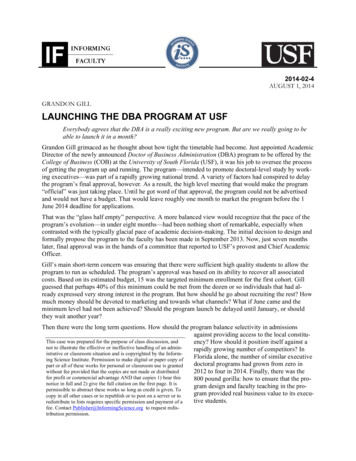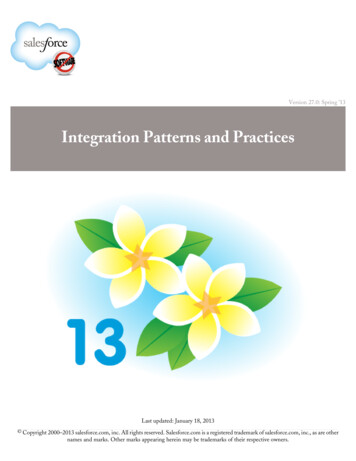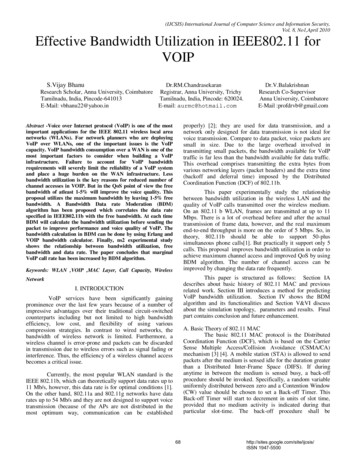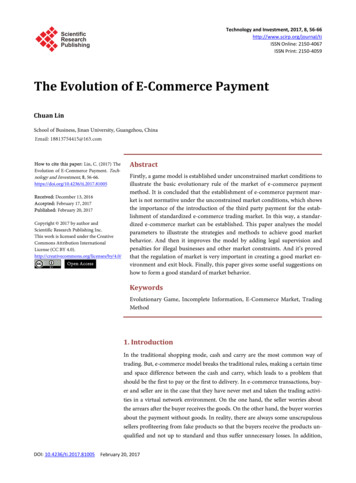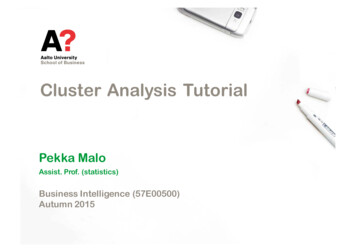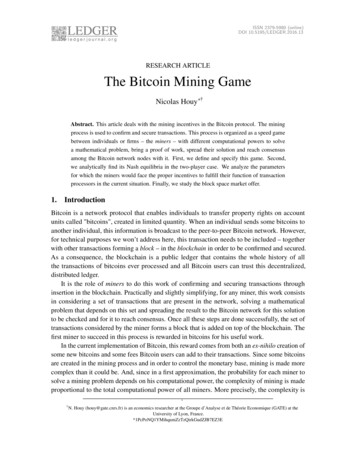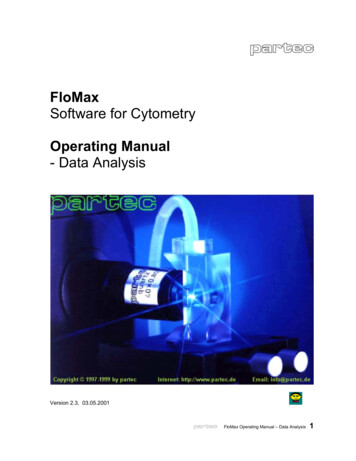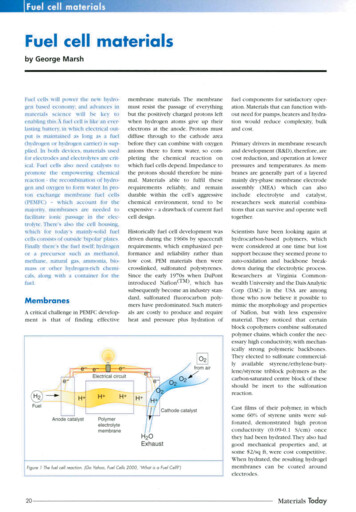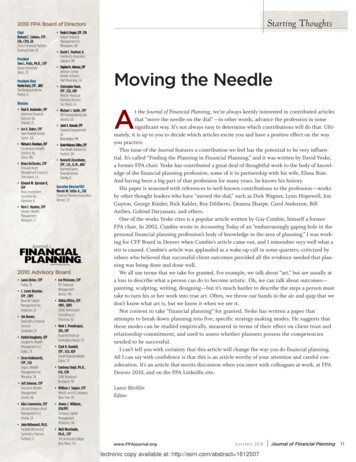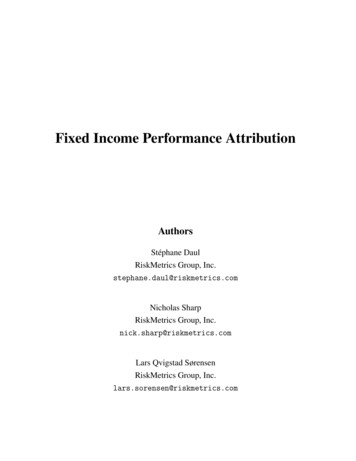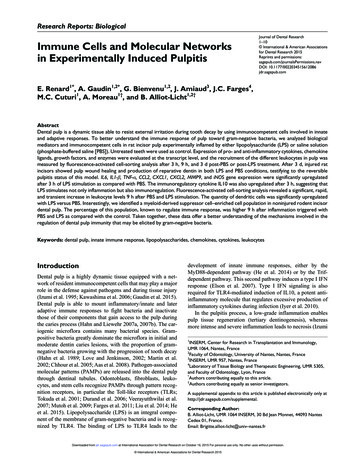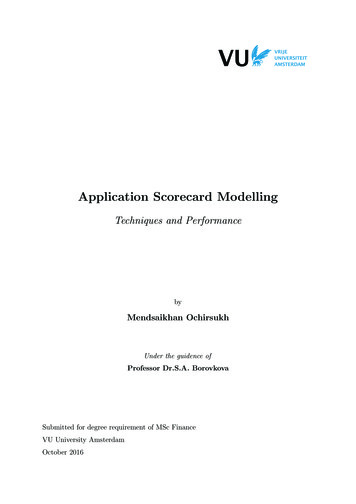
Transcription
Application Scorecard ModellingTechniques and PerformancebyMendsaikhan OchirsukhUnder the guidence ofProfessor Dr.S.A. BorovkovaSubmitted for degree requirement of MSc FinanceVU University AmsterdamOctober 2016
VU University AmsterdamApplication Scorecard Modelling:Techniques and PerformanceSummaryThis research aims to review and assess methods for improving the predictive power of creditscoring modelsImprovingfor Auto-Leasingbusiness. Wethe process-flowinvolved in the scorecardPerformanceof examineSME ApplicationScorecard:modeling and highlightAutothe probablecauseofweakmodelperformance.Such examinationleasing Industry, Italian Case Studywould include theoretical and empirical assessment of data quality, variable transformation andselection, statistical tests for model performances and so on.Moreover, we aim develop an application scorecard based on automated binning algorithms andassess its validity and practicality for lassificationmethodologyMissingvalue/outliers, orinsufficient dataUnivariate &multivariateanalysisIdentificationof (potential)risk driversFigure 1: Diagram of Modeling Process2Fig0. Research Focus TreeModelPerformancecheck
AcknowledgementsWith boundless excitement and appreciation, I would like to express my sincere gratitude to thepeople who helped for the successful completion of this thesis work:To my supervisor, Dr.Svetlana Borovkova for the continuous support of this research and myMSc study, for her generous advice, immense knowledge and encouragement. I could not haveimagined having a better mentor and role model.To the Director Risk Management at LeasePlan Corp, Natalia Migal, for hiring me as an internand giving the opportunity to do this research. Her cheerful and vibrant personality has alwaysbeen my inspiration.To my beloved team: my Senior manager, Alex Suanet, for all the kind support, genuine advise, and patience.Without his expertise in scorecard and constructive guidance, this work would not havebeen accomplished. my manager, Yan Zhou, for her generous support and guidance through the modellingprocess. Her kindness will always be remembered and appreciated. my managers, Emily and Micheal, for all the fond memories and kind support.To my friends, Sardana, Saiganesh, Neil, Evgeny, Nandin and Kate, for their companionship.At most, to my family whom I love the most. My parents, Ochirsukh and Ariunjargal, mygrandmother Bilegmaa, my aunt Ariunzul, and my sister Enkhmend, for their unconditionallove.3
Contents1 Introduction61.1Background : Credit Scoring Models . . . . . . . . . . . . . . . . . . . . . . . . .81.2Application Scorecards for Auto-leasing Business . . . . . . . . . . . . . . . . . .91.3Literature Review & Research Contribution . . . . . . . . . . . . . . . . . . . . .92 Scorecard Development2.12.22.311The Data . . . . . . . . . . . . . . . . . . . . . . . . . . . . . . . . . . . . . . . .112.1.1Data Quality . . . . . . . . . . . . . . . . . . . . . . . . . . . . . . . . . .112.1.2Missing Values . . . . . . . . . . . . . . . . . . . . . . . . . . . . . . . . .122.1.3Reject Inference . . . . . . . . . . . . . . . . . . . . . . . . . . . . . . . .14Modelling Framework . . . . . . . . . . . . . . . . . . . . . . . . . . . . . . . . .152.2.1Logistic Regression Model . . . . . . . . . . . . . . . . . . . . . . . . . . .152.2.2Decision Tree Models : Pruned & Ensemble Tree Models . . . . . . . . .162.2.3Neural Network Model . . . . . . . . . . . . . . . . . . . . . . . . . . . . .19Performance Measures . . . . . . . . . . . . . . . . . . . . . . . . . . . . . . . . .213 Automatic Binning Process3.123Binning Process . . . . . . . . . . . . . . . . . . . . . . . . . . . . . . . . . . . . .233.1.1Manual binning vs Automated binning . . . . . . . . . . . . . . . . . . . .243.2Simple Binning Algorithms: Equal size and Equal width binning . . . . . . . . .253.3Recursive Partitioning Algorithms . . . . . . . . . . . . . . . . . . . . . . . . . .253.4Monotonic Adjacent Pooling Algorithm . . . . . . . . . . . . . . . . . . . . . . .263.5Cluster Binning Algorithm for Categorical Variables . . . . . . . . . . . . . . . .273.5.130WoE based Cluster Binning Algorithm . . . . . . . . . . . . . . . . . . . .4 Empirical Analysis and Results314.1Data Description and Sampling . . . . . . . . . . . . . . . . . . . . . . . . . . . .314.2Initial Variable Selection . . . . . . . . . . . . . . . . . . . . . . . . . . . . . . . .324
4.2.1Automated Binning Models . . . . . . . . . . . . . . . . . . . . . . . . . .344.3Final Variable Selection . . . . . . . . . . . . . . . . . . . . . . . . . . . . . . . .384.4Performance Evaluation: Testing for Discriminatory Power . . . . . . . . . . . .384.5Model Selection and Assessment . . . . . . . . . . . . . . . . . . . . . . . . . . .405 Conclusion41A Equations & Terminologies46A.0.1 Weight of Evidence . . . . . . . . . . . . . . . . . . . . . . . . . . . . . . .46A.0.2 Information Value . . . . . . . . . . . . . . . . . . . . . . . . . . . . . . .46B R Packages47B.0.1 RPART . . . . . . . . . . . . . . . . . . . . . . . . . . . . . . . . . . . . .47B.0.2 CTree . . . . . . . . . . . . . . . . . . . . . . . . . . . . . . . . . . . . . .47B.0.3 Smbinning . . . . . . . . . . . . . . . . . . . . . . . . . . . . . . . . . . . .48B.0.4 Optimal K-Means Clustering . . . . . . . . . . . . . . . . . . . . . . . . .48C Additional Graphs49C.1 Age legal representative . . . . . . . . . . . . . . . . . . . . . . . . . . . . . . . .49C.2 Score credit bureau . . . . . . . . . . . . . . . . . . . . . . . . . . . . . . . . . . .50C.3 Delinquency Rate 1Quarter . . . . . . . . . . . . . . . . . . . . . . . . . . . . . .515
Chapter 1IntroductionIn this research, we focus on application scorecard development process for assessing credit riskof retail businesses and small medium enterprises (SMEs). According to Allen et al. (2003), academic researchers had been mainly focused bank risk models, and meanwhile the area of retailcredit risk remained relatively underdeveloped. This was mainly due to the lack of availabledata to the researchers. Moreover the retail loans and credit sector had shown slower progressin terms of development of credit risk models. Gradually, the retail sector has become of interest to regulators and researchers due to it’s growing importance with increasing volumes ofoutstanding credit.Construction and maintenance of a scorecard model require quite a number of stages,including data preparation, model development, training & validation, calibration, implementation, overrides & controls, and monitoring (Anderson, 2007). Given the tediousness of completingall the stages, we focus on only particular parts of the model development process.The primary influences in the modelling process are:1. The amount of available data2. Business usage and modelling purpose3. Available techniques and platforms(1) Our data was provided by LeasePlan1 entity in Italy (LPIT) and we developed severalmodels whose performances are bench-marked by current LPIT application scorecard. (2) Thescorecards are developed for the purpose of automated approve/reject decisions for the creditportfolio of retail businesses and small medium enterprises. (3) We used R programming language for our scorecard development process due to its wide variety of available graphical andstatistical programming features.1LeasePlan is an international company of Dutch origins specialized in fleet management.6
In Chapter 1, we start our research with basic background check on credit scoring models.Then, we move to the topic of scorecard development process in Chapter 2. In section 2.1we mainly focus on data quality issues and handling of missing values in data set. Decentquality of data is of main importance since the scorecard performance is heavily dependent onthe underlying data. Number of techniques have been suggested by researchers to deal withthe missing values in data, including depletion and imputation techniques. When the missingrate in the data set is large, depletion technique has a danger of leading to information loss.Also, a selection of proper imputation technique must be considered with utmost caution sinceit can lead to serious bias. Alternatively, we treated the missing values in a particular predictorvariable by placing its missing values into separate bucket/class. This separate class approachis mainly used in credit scoring models through the variable transformation and binning process(Fleming, 2013).For the rest of the Chapter 2, we review popular modelling techniques for scorecards andtheir suitability for business implementation. It’s important for an application scorecard tohave interpretable outcome, so that the decision logic can be understood, where the companiesmust advise decision reasons to customers (Anderson, 2007). Decision trees based on simplerecursive partitioning algorithms provide easy to interpret outcomes, however their performanceappear to be modest due to their unstable nature. Boosted tree and Neural Network modelsperform relatively well, however at the expense of interpretibility. Therefore, we proceed ourrest of research building on logistic regression models, given their ease of interpretability andacclamatory robust performance.In most cases the attributes of predictors are segmented into grouping intervals, with theaim of creating bins for the model that maximize the correlation with these attributes (Oliveiraet al., 2008). Variable transformation through binning is an essential part of logistic regression model development process as the characteristics of bins, measured by weight-of-evidence(WoE), impacts the predictive power of credit scoring model. Proper binning of a predictor variable is subject to certain constraints, including min/max number of bins, min/max percentagesof observations per bin, and monotonicity of aggregate bin WoE values etc. Such constraintsand assumptions, that depend on availability and nature of the data, can make the binning process tedious, especially when enforced manually and when the number of predictors are large.Automated binning processes can drastically reduce the time and efforts spend on scorecarddevelopment process and reduce the risk of eliminating significant variables when using variablereduction techniques. Therefore, in Chapter 3 we review possible algorithms for automated7
binning process, and their underlying techniques and theories.We built several logistic regression models based on these algorithms and assessed their performances in Chapter4. Our proposed automated binning model, MAPA Clust, which employsMonotonic Adjacent Pooling Algorithm in combination with cluster analysis, effectively bins thepredictor variables and outperforms the benchmark model. Finally, Chapter 5 concludes witha summary of the key findings in this research work.1.1Background : Credit Scoring ModelsPerhaps the simplest way to explain credit-scoring is to separate the word components into”credit” and ”scoring”, where the word credit represents borrowers willingness and ability topay back, as well as the potential financial impact due to observed or perceived changes in borrower’s creditworthiness. Meanwhile, the word ”scoring” implies ranking and ordering of casesor borrowers according to their perceived or observed quality which may distinguish into theseparate groups of good and bad borrowers. Hence, credit scoring is the use of statistical modelsand techniques to translate relevant data of into numerical scores that guide credit decisions.Generally, higher the estimated score, less the riskiness of the client, and thus more reliable theclient is perceived.In general, credit portfolio of banks or financial institutions consist of business (small,medium, large, retail, ect.) portfolios and individual(private clients) portfolios. Perhaps, creditworthiness of larger companies may assessed based on the ratings of external agencies, such asStandard & Poor’s, Moody’s or of credit bureaus. Those external ratings, however, are mostlynot available for individual clients, retails or small medium enterprises, and hence the applications are required to go through internal screening.Scorecard models can be described as type I model and type II model, such that typeI models are used as an input for PD and LGD models, whereas type II models are application scorecard for approval or reject decision making. Application scorecards are well-suited inhigh-volume and low-value environments, and they replace the traditional approach to creditassessment based on expert judgements and reduces the time of application to be processedthrough the credit committee. As we boil down all the concepts into a single sentence, the mainprinciple of credit scoring system is to be an optimal classifier which can assign a score to eachborrowers in order to differentiate the bad clients from the good clients.8
1.2Application Scorecards for Auto-leasing BusinessApplication credit-scoring models for leasing slightly differ from the models developed for banklending. According to Caire (2005), bank lending scorecards mainly concern in quantifying anapplicant’s likelihood of default on a credit obligation. Models for leasing assets also aims toassess the client’s default risk, but with additional considerations embedded, including the assetworth and vendor relationships, which affect the overall risk of the lease contract. Here below,we mention the three most important differing factors in accordance with Caire (2005): Banks take pledge against the financed assets, and perhaps some additional assets forcollateral purpose. Meanwhile, lessors (leasing companies) are entitled to the financedasset as they legally owns them. Leasing companies work closely with particular selection of vendors that usually providebuy-back guarantees. Such guarantees can mitigate the risks of bad deals. Most leasing companies offers financing packages for standard equipments that generallyhave liquid secondary markets, such as automobiles and vehicles.These intrinsic differences between loan and leasing risk imply that the leasing models shouldfocus on not only on the client’s inherent default risk, but also on the expected loss or profitfrom asset sale in the event of default. Consequently, such kind of additional considerationmay require longer development process for the model. Thus, more we automate the modellingprocess, faster it is to process additional factors and easier it is to validate the model; i.e.automated binning process.1.3Literature Review & Research ContributionWe believe that our research findings contribute to the field of credit scoring in two ways:1. We focus on automated binning process.One may find extensive collection of researches on variety of topics related to credit scoringmodels. However, we believe that automated binning process is one of the least exploredsubject among the previously written literatures. The most elaborate explanations ontechniques and algorithms of binning process can be found in textbooks like The CreditScoring Toolkit by Anderson (2007), Business Modelling and Data Mining by Pyle (2003), and Credit Scoring and Its Applications by Thomas et al. (2002). Another useful sourcesare user guidelines and documentations on automated binning tools implemented commercial statistical softwares like SAS and Matlab, as well as binning packages developed on9
open sources like R and Phyton (see Refaat, 2007; Jopia, 2016; Oliveira et al., 2008) . Oneshould also take a look at Zeng (2014) for theoretical derivations of necessary conditionsfor a good binning algorithm. In this work, we review and assess performances of popular binning algorithms and tools, in comparison with manual binning based on expertknowledge. We believe such assessment can be an additional contribution.2. We propose a new binning method for nominal variables: WoE based Cluster BinningAlgorithmAutomated binning algorithms based on clustering of homogeneous attributes of predictorvariable very common in the field of pharmacomerics2 . Decent examples can be foundfrom Sonehag et al. (2012) and Nugent and Stuetzle (2010), where they employ clusteranalysis for selection of the number of bins for simulated data on drug uptake, effects andelimination. However, these pharmacometrics models simply measure the lasting effect ofdrug in human body over time, rather than accounting for any related risk or side effects.Moreover, cluster analysis is an unsupervised learning which does not account for anyrelationship between the predictor and target variables. On the other hand, it’s essentialfor the credit risk models that characteristics of bins to be representative of default risk,i.e. higher income class clients should be less risky than lower income class clients (O.Dudaet al., 2000). Due to this reason, the binning approach based on cluster analysis has notbeen explored yet, or scarce literatures can be found if there’s any, in the frameworkof scorecard modelling. To account for the relationship between target variable and apredictor variable, we cluster the factor observation based on their Weight-of-Evidence(WoE). Similar binning suggestions based on WoE, such as collapsing adjacent attributeswith similar WoE scores is demonstrated in (Bhalla, 2015).2Mathematical modelling of biology, pharmacology, and physiology used to quantify interaction between drugintake and patients.10
Chapter 2Scorecard Development2.12.1.1The DataData QualitySuccessful performance of a scorecard depends mostly on the data used during the developmentstage. Therefore, the first issue that needs to be addressed is the quality of available data. Dataquality issues mainly concern with: accuracy consistency completeness of the data set (Baesens et al., 2003; Lindsay et al., 2010)Perhaps, common example accuracy issue in the data relates to the user input errors or errorsin software. Data completeness refers to which values are missing in the data (Parker et al.,2006). Data consistency relates to situations in which multiple data sources are used and dueto lack of standardisation, where data items may conflict with each other.Moreover, sufficiency in the quantity of data is required to ensure construction of goodquality and robust scorecard models. Usually in application scorecard modelling, it’s recommended to use 1,500 instances of each class, where reject inference is performed and an additional1,500 rejected applicants are required.Validity of this recommendations is based on the understanding that the composition of creditscoring data set is homogeneous across lenders and regions. For example, consider the differentsources of data construction (Crone and Finlay, 2012): Internal : This type of data offers insight into the behavioural accounts of the client. External: This type of data is obtained from application forms, financial statements etc.11
Bureau : This relates to data recorded by credit bureau and court instances. Credit bureauare institutions that collect data on the performance of loans granted by a different lenders.Finally, the dataset should contain enough instances, including the default instances, to restrictthe occurrence of correlated variables which result on over-fitting of the credit-scoring model.2.1.2Missing ValuesDealing with missing values in our data set was one of the serious issues we confronted within this work, as the missing data can seriously bias credit scores. We considered number ofpossible techniques, including the multiple imputation techniques. But, before the selection ofappropriate approach to missing data, one keep in mind that the suitability of the approach is dependant on underlying missing data mechanism of the respective data (Galler and Kehrel, 2009).Mechanism of Missingness: Missing Co
quality of data is of main importance since the scorecard performance is heavily dependent on the underlying data. Number of techniques have b
